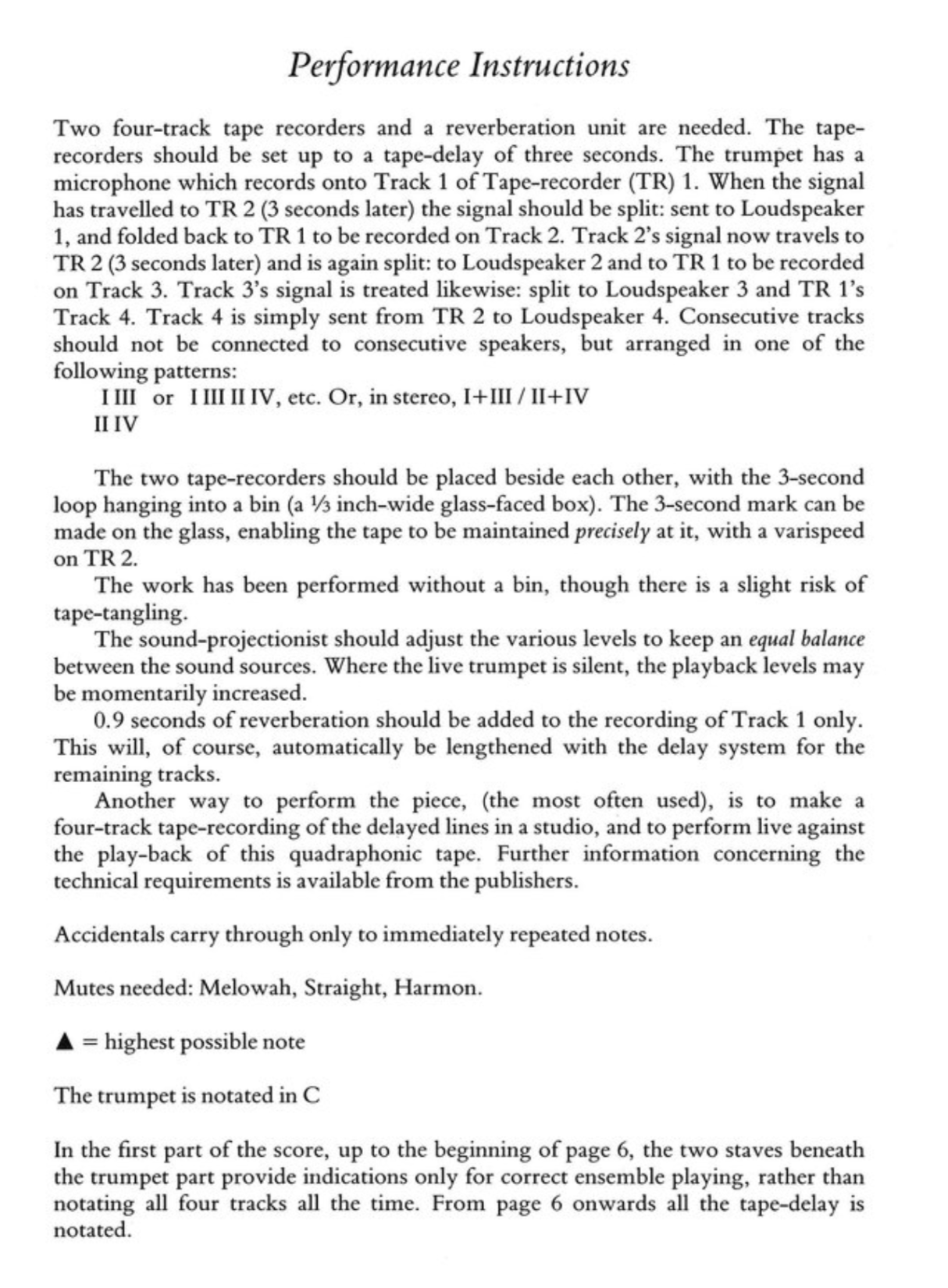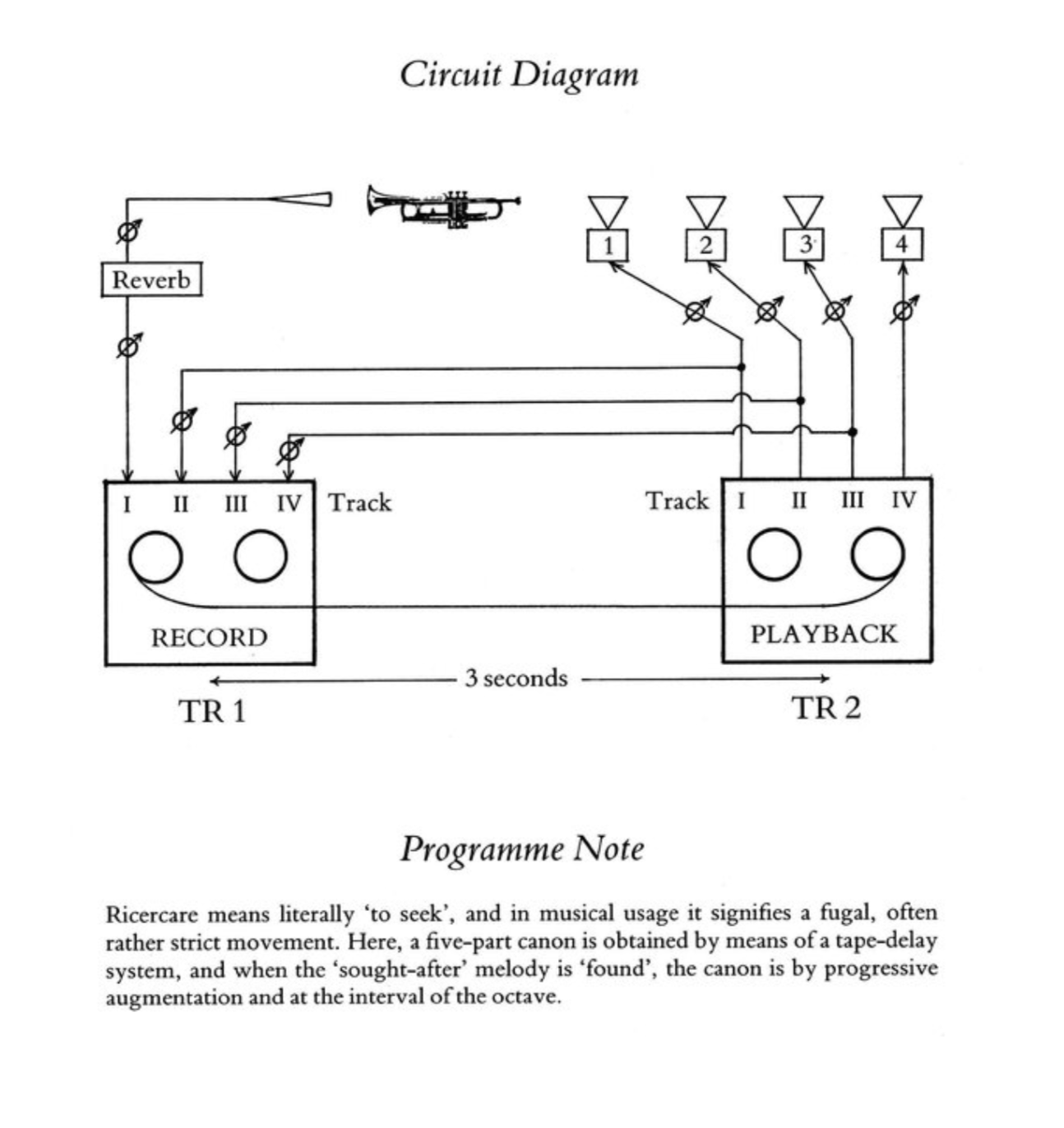Table of contents
Documentation date: 30 avril 2020
Version state
Valid
Validation date: 2 mai 2020
Version documentalist
- demoulin (Etienne.Demoulin@ircam.fr)
Version realisation
- Alexis Baskind (Computer Music Designer)
- Elsa Biston (Computer Music Designer)
Version length
6 mnUpgrade Motivation
documentation update
Comment
untested in concert !
Other version(s)
Detailed staff
- soliste : trompette
Electronic equipment list
Computer Music Equipment
-
1 Macintosh - Apple Desktops
(Apple)
-
1 Max 8 - Max
(Cycling74)
-
1 Fireface 802 - Sound Board
(RME)
-
1 Footswitch / Sustain Pedal - Footswitch / Sustain Pedal
-
1 iConnectMIDI2+ - MIDI Interfaces
(iConnectivity)
Audio Equipment
-
1 Microphone - Microphone
-
4 Loudspeaker - Loudspeakers
Work related information
Premiere
- 10 janvier 1985, <p>Royaume-Uni, Londres, Purcell Room</p>
Publisher :
- Faber Music
Realisation
- John Whiting
Work length
- 6 mn
Useful links on Brahms
- Ricercare una melodia pour trompette et dispositif électronique (1984), 6mn
- Jonathan Harvey
| File | Author(s) | Comment | |
|---|---|---|---|
| Download [53,3 Kio] | Patch Ricercare-2020 |
Instructions
Audio setup
This is a lightweight patch and does not require a powerful computer.
You will need a soundcard with 1 input and 4 outputs.
Loudspeaker setup
The routing of outputs 1-4 depends on the particular system configuration (requires a 4-channel audio card). You can change the output channels number with the four number boxes, bottom left, near the dac object. The outputs 1 to 4 correspond to the loudspeakers like this :
1 3
2 4
Midi setup
use a midi pedal to trigger events.
pedal settings : set the input controller midi name, controller number, pedal polarity. It may be useful to open "p infoctlin" to monitor the midi input messages your computer receives.
DSP setup
double-click on the dac~ object opens the dsp status window, where you can choose the sound driver, etc.
The four number boxes above the dac~ object let you change the names or orders of the outputs : for instance, when in rehearsal, you can output on "1 2 1 2" if you've got only two output channels.
Software installation
put the folder Ricercare-2020 in your file preferences directory and launch Ricercare-2020.maxpat
System calibration and tests
Level settings. It's always better to let the master out level at the maximum;
Part one has one fader, because the output signals are exactly the same in the four loudspeakers (but delayed)
Part three has four faders, corresponding to the four transpositions, or to the four sounds, and to the four loudspeakers.
Initialization routine
clicking on "reset" open the dac, pedal reception, initializes patchers and cues;
makes it ready to play from the beginning.
For the rehearsal, clik and drag on the number box "Next Cue" : the patch wait for a pedal trigger or space bar to play that cue.
"enter" stops the event being played and re-position at the beginning of this cue (waiting for pedal trigger or space bar).
Patch presentation
What happens? :
1. incoming signal is delayed 3 sec in channel 1, and 6, 9, 12 sec respectively in channels 2, 3, 4.
2. Start automatic fader play
3. Fade out
4. close the delay lines
5. after 6, 18, 42, 90 sec, with the same durations the incoming signal is transposed, delayed and feds the channels 1, 2, 3, 4
6. stops the recording of the buffer for transpositions
7. 12 sec fade out
Performance notes
this version has not been played in concert.
Performance Instructions from the original analog version


Program note
La pièce a été écrite initialement pour trompette mais peut être jouée par tout instrument. Il en existe des versions pour trombone, hautbois et violoncelle. « Ricercare » signifie littéralement « rechercher ». Dans le langage musical ce terme désigne un mouvement de fugue, souvent assez strict. Ici, l’écho électrique (« delay ») assure un canon à cinq voix, dont émerge une mélodie résultante. Un second canon se développe alors, dans lequel chaque voix nouvelle est traitée cette fois à demi-vitesse et une octave plus basse que la précédente.Jonathan Harvey, note de programme du concert ManiFeste du 25 juin 2021 au Centre Pompidou
Version documentation creation date: 30 avril 2020 12:01, update date: 30 juin 2023 11:27